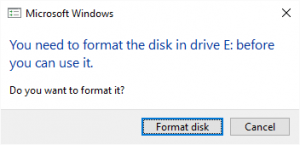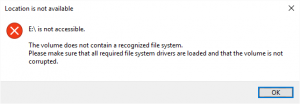A very common symptom of a failing hard drive is for Windows to pop up with a message saying, “You need to format the disk in drive E: before you can use it.” From the perspective of Windows, this message is brought up for a couple of reasons:

The Boot Sector(BS) is Damaged or Missing
This is the first sector of every partition on a hard drive which contains key information necessary for the operating system to identify how many sectors are in the partition, which sector contains the start of the file table (ie, MFT for NTFS) and other data useful to the operating system accessing the data in the partition. When this sector is damaged or missing, the operating system assumes that the partition must not be formatted.
The File Table is Damaged or Missing
 The file table is like a table of contents giving details about the files and folders such as their names, folder structure and where they are located on the drive. If Windows is unable to fully read through the MFT, it will fail to load the file structure and pop up a message that the drive needs to be formatted.
The file table is like a table of contents giving details about the files and folders such as their names, folder structure and where they are located on the drive. If Windows is unable to fully read through the MFT, it will fail to load the file structure and pop up a message that the drive needs to be formatted.
Why?
This is the key question that should be asked before trying to deal with the issues. We can appreciate that it seems to make sense to try and recreate the missing boot sector or to run a file system check to repair the file table, but neither of these actions will correct the root cause of the damage and will likely just result in unnecessary data loss.
The typical reasons for these symptoms are due to bad sectors, firmware issues, failing PCB and/or failing heads. It is critical that the correct course of action is taken, based on the root cause, as follows:
Bad sectors: get a full sector-by-sector clone/image of the drive and then attempt file system repair/recovery on the stable copy.
Firmware issues: this usually requires professional data recovery equipment to fix the offending firmware modules and then get a full sector-by-sector clone/image of the drive and then attempt a file system repair/recovery on the stable copy.
Failing PCB: fix or replace the damaged circuit board. The circuit board usually has unique data stored on it and almost always needs that information transferred to the donor board in order for it to be compatible with the patient drive. Then get a full sector-by-sector clone/image of the drive and then attempt a file system repair/recovery on the stable copy.
Failing heads: in most cases, bad heads means that the drive will not even identify to the computer and usually involves bad sounding noises. However, it is not uncommon for drives to have heads that work enough to look like they are healthy, but not enough to properly read the data from the platter surfaces. Damaged heads are usually accompanied with bad sectors, so again, it is important to get a full sector-by-sector clone/image of the drive after the heads are replaced with a healthy set. And, again, attempt a file system repair/recovery on the stable copy.

Sadly, we frequently get drives after destructive DIY methods are attempted without first dealing with the root cause. Although it doesn’t quite fall under the same symptoms here, we even had a drive brought into us that the tech had frozen over night in attempt to recover the data. The root cause of the problem? Someone had formatted the drive and there wasn’t even a single bad sector on the drive.
If you are experiencing this type of issue, please be very careful on how you and/or your technician deal with it. If you value your data, it is best to have your hard drive assessed by data recovery professionals, like the team at Recovery Force. In most cases, Recovery Force is able to recover the data from this type of issue at our minor recovery rate and it is usually completed within a couple business days.
Should you want to talk to one of our team members about your specific issue, call us at 866-750-3169. We are happy to answer your questions.